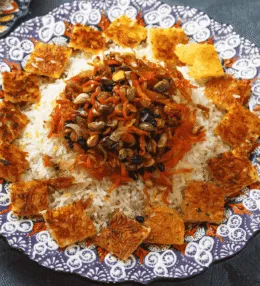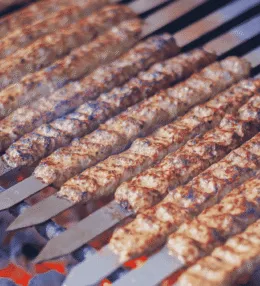
- View
Table of Contents
ToggleBibingka is one of the Philippines’ most beloved rice cakes. Soft, gently sweet, and baked in banana leaves, it is a treat that fills the air with the aroma of coconut and warm dough. Often enjoyed around Christmas, it has a way of making any morning or evening feel festive.
There is something very inviting about a freshly made bibingka. The scent of toasted leaves, the golden top with a hint of char, and the tender crumb inside all combine to create a cake that is comforting yet celebratory at the same time.
It is sold by vendors outside churches, in market stalls, and even in modern cafés, yet it never loses that homemade character. A simple slice has the power to stir memories of early mornings and shared family tables.
Want to dive deeper into Filipino Cuisine? Don’t miss our post on 28 Traditional Filipino Foods to Try
What Is Bibingka?
Bibingka is a type of rice cake that is baked rather than steamed, which makes it different from many other Filipino delicacies. Traditionally it is cooked in clay pots lined with banana leaves, using heat above and below.
The cake itself is made from rice flour blended with coconut milk, water, sugar, and sometimes a little salted duck egg or cheese on top. This mixture gives it a texture that sits somewhere between a soft cake and a light pudding.
What comes out of the oven is a golden round cake, often brushed with butter and topped with coconut flakes or slices of cheese. It is best eaten warm, still fragrant from the leaves that cradle it during baking.
Ingredients and Taste
The heart of bibingka lies in its use of rice flour and coconut milk. These give it a naturally gentle sweetness and a soft crumb that is both rich and light. Eggs and sugar provide structure and depth, while banana leaves lend their aroma as it bakes.
Toppings can vary, but a traditional bibingka often carries slices of salted egg or a scattering of cheese. These savoury touches create contrast, while grated coconut or a drizzle of butter adds another layer of comfort.
When tasted, bibingka is never cloying. It is delicate, lightly sweet, and subtly smoky from the toasted leaves. The combination of soft cake, salty topping, and coconut makes each bite full of flavour without feeling heavy.
A Taste of History
Bibingka has roots that stretch back to pre-colonial times, when rice flour and coconut milk were common staples. Early versions were cooked over embers, a method that has shaped its taste and texture even today.
In Spanish colonial times, the cake became part of Christmas traditions, served after dawn masses during the Simbang Gabi season. It became linked to celebration and community gatherings in the cool December mornings.
Even as modern ovens replaced clay pots, the tradition of using banana leaves and slow baking has held strong. Bibingka continues to be a favourite during holidays and a year-round treat that speaks of Filipino warmth.
Today it stands as more than a cake. It represents the way Filipino food blends simple local ingredients with methods passed down over generations, creating something timeless and full of character.
How to Make Bibingka (Filipino Rice Cake)
Bibingka is a classic Filipino Christmas delicacy, a soft rice cake baked in banana leaves and topped with salted egg, cheese and a touch of butter. The process is simple yet rewards you with a fragrant, gently sweet cake that is slightly crisp on the outside and tender inside. See the recipe card at the bottom for printable directions
Ingredients
For the batter
- 200 g rice flour (preferably glutinous rice flour mixed with regular rice flour, 50:50)
- 1 tsp baking powder
- 100 g caster sugar
- 200 ml thick coconut milk
- 150 ml fresh milk
- 2 large eggs
- 50 g unsalted butter, melted
For topping
- 1 salted duck egg, sliced
- 50 g mild white cheese (queso de bola or mild cheddar), sliced thin
- 2 tbsp desiccated coconut, lightly toasted
- 2 tbsp softened butter for brushing
Additional
- Banana leaves, cut and softened over flame or hot water
- A pinch of sea salt
Cooking Instructions
Step 1: Prepare the oven and banana leaves
To begin, preheat the oven to 190°C. Line small round tins or ramekins with softened banana leaves, letting them overhang slightly. This step gives Bibingka its signature aroma. Move to mixing the dry ingredients.
Step 2: Mix the dry ingredients
In a large bowl, whisk together rice flour, baking powder, sugar and a pinch of sea salt until combined. This prevents clumps later and ensures even texture. Transition to the wet ingredients.
Step 3: Prepare the wet mixture
In another bowl, beat eggs lightly. Add coconut milk, fresh milk and melted butter, whisking until smooth. Avoid overbeating to maintain a tender crumb. Prepare to combine wet and dry mixtures.
Step 4: Combine the batter
Gradually pour the wet mixture into the dry ingredients, whisking gently to form a smooth batter. Aim for a consistency similar to thick cream. Allow it to rest for 10 minutes to hydrate the flour. Move to filling the tins.
Step 5: Fill the prepared tins
Ladle the batter into the banana leaf-lined tins, filling each to about two-thirds full. This leaves room for rising. Prepare to add toppings.
Step 6: Add traditional toppings
Arrange slices of salted duck egg and cheese on the top of each cake. These toppings sink slightly as the cake bakes, infusing savoury flavour throughout. Move to baking.
Step 7: Bake the Bibingka
Place the tins on a baking tray and bake for 25–30 minutes until golden and a skewer inserted into the centre comes out clean. The edges will form a light crust. Transition to finishing touches.
Step 8: Brush with butter
Once out of the oven, immediately brush the hot tops with softened butter. The heat melts the butter, giving sheen and extra richness. Prepare for final garnishing.
Final step: Garnish and serve
Sprinkle lightly toasted desiccated coconut over the warm cakes. Serve hot with grated cheese and more salted egg slices if desired. Bibingka is best enjoyed fresh with hot tea or coffee.
Variations and substitutions
- If banana leaves are not available, line tins with baking parchment to prevent sticking (you will lose the signature aroma).
- Use macadamia nuts or Brazil nuts for a milder topping if salted duck egg is hard to find.
- Swap fresh coconut milk for good-quality tinned coconut milk.
- Mild cheddar can be used instead of queso de bola.
Cooking Tips for Perfect Bibingka
- Always preheat the oven fully before baking to ensure an even rise.
- Use a mix of glutinous and regular rice flour for authentic soft yet slightly chewy texture.
- Briefly toast banana leaves over an open flame to make them pliable and aromatic.
- Serve Bibingka warm as it loses its tender texture when cooled completely.

Filipino Bibingka (Rice Cake)
Ingredients
For the batter
- 200 g rice flour preferably glutinous rice flour mixed with regular rice flour, 50:50
- 1 tsp baking powder
- 100 g caster sugar
- 200 ml thick coconut milk
- 150 ml fresh milk
- 2 large eggs
- 50 g unsalted butter melted
For topping
- 1 salted duck egg sliced
- 50 g mild white cheese queso de bola or mild cheddar, sliced thin
- 2 tbsp desiccated coconut lightly toasted
- 2 tbsp softened butter for brushing
Additional
- Banana leaves cut and softened over flame or hot water
- A pinch of sea salt
Instructions
- To begin, preheat the oven to 190°C. Line small round tins or ramekins with softened banana leaves, letting them overhang slightly. This step gives Bibingka its signature aroma. Move to mixing the dry ingredients.
- In a large bowl, whisk together rice flour, baking powder, sugar and a pinch of sea salt until combined. This prevents clumps later and ensures even texture. Transition to the wet ingredients.
- In another bowl, beat eggs lightly. Add coconut milk, fresh milk and melted butter, whisking until smooth. Avoid overbeating to maintain a tender crumb. Prepare to combine wet and dry mixtures.
- Gradually pour the wet mixture into the dry ingredients, whisking gently to form a smooth batter. Aim for a consistency similar to thick cream. Allow it to rest for 10 minutes to hydrate the flour. Move to filling the tins.
- Ladle the batter into the banana leaf-lined tins, filling each to about two-thirds full. This leaves room for rising. Prepare to add toppings.
- Arrange slices of salted duck egg and cheese on the top of each cake. These toppings sink slightly as the cake bakes, infusing savoury flavour throughout. Move to baking.
- Place the tins on a baking tray and bake for 25–30 minutes until golden and a skewer inserted into the centre comes out clean. The edges will form a light crust. Transition to finishing touches.
- Once out of the oven, immediately brush the hot tops with softened butter. The heat melts the butter, giving sheen and extra richness. Prepare for final garnishing.
- Sprinkle lightly toasted desiccated coconut over the warm cakes. Serve hot with grated cheese and more salted egg slices if desired. Bibingka is best enjoyed fresh with hot tea or coffee.
Nutrition
You May Also Like







Leave a Review